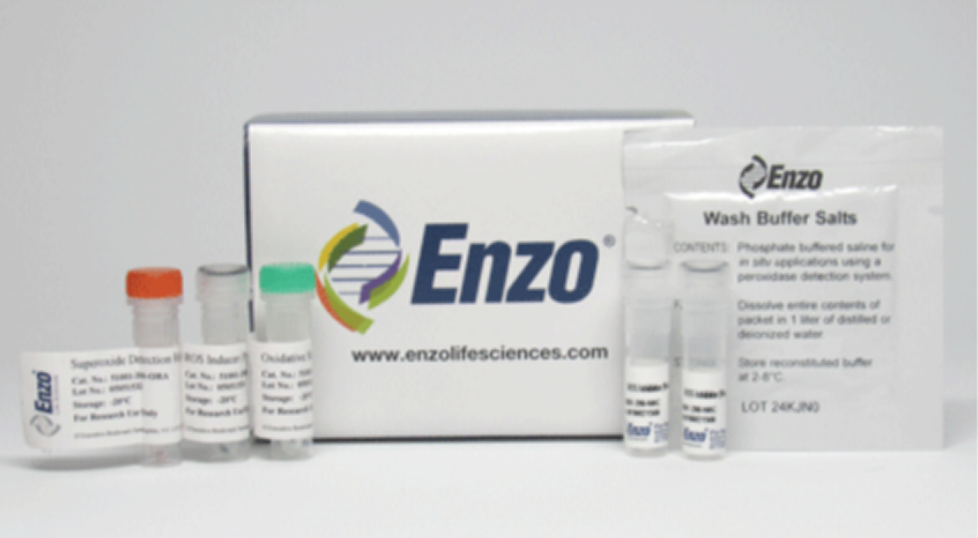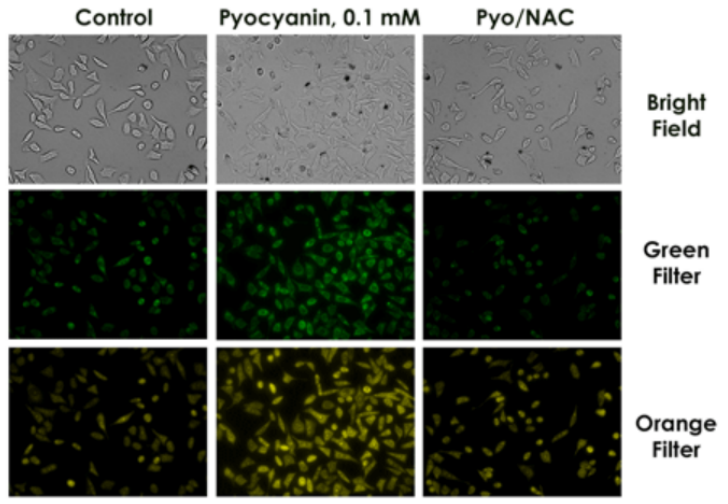ROS-ID?总活性氧/超氧化物检测试剂盒
Enzo Life Sciences的ROS-ID??Total ROS/Superoxide detection kit包括两种荧光染料作为主要成分:非荧光、可渗透细胞的氧化应激检测试剂(绿色,Ex/Em 490/525 nm)与多种活性物质(过氧化氢、过氧亚硝酸根和羟基)直接反应,产生绿色荧光产物。超氧化物检测试剂(橙色,Ex/Em 550/620 nm)是一种可渗透细胞的探针,可与超氧化物特异性反应,产生橙色荧光产物。试剂盒还提供Pycyanin(ROS诱导剂)和NAC(ROS抑制剂)。

产品特点
●?用于检测活细胞中超氧化物的产生
●?与细胞培养基的主要成分(酚红,FBS和BSA)兼容
●?已通过显微镜、流式细胞仪和微孔板等应用验证
实验示例

图1. 在加入了ROS/超氧化物检测试剂并用绿脓菌素处理的 HeLa 细胞中,通过荧光显微镜对活性氧的形成进行了分析。在绿色通道中监测一般氧化应激水平,而在橙色通道中检测超氧化物的产生。用 NAC(一种通用的 ROS 抑制剂)预处理可防止 ROS 的形成。

图2. 使用ROS-ID??Total ROS/Superoxide detection kit和ROS清除剂/抑制剂分析用抗霉素A(AMA,特异性超氧化物诱导剂)、叔丁基-过氧化物(TBHP,特异性过氧化物诱导剂)和绿脓菌素(通用ROS诱导剂)处理的HeLa细胞中ROS的产生。使用U-2 OS和CHO K1细胞获得了类似的结果。

图3. 通过流式细胞术分析Hela细胞中ROS的形成。数据以绿脓菌素(ROS/SO诱导剂)、TBHP(ROS 诱导剂)和 AMA(超氧化物诱导剂)处理后的阳性百分比表示。绿色柱表示ROS 阳性率%,橙色柱表示超氧化物阳性率%。
产品信息
| 产品货号 | ENZ-51010 / 欣博盛生物 |
| 产品名称 | ROS-ID??Total ROS/Superoxide detection kit |
| 别名 | Reactive oxygen species / Superoxide |
| 规格 | 1*1Kit (200 fluorescence microscopy assays or 50 flow cytometry assays or 2x96 microplate assays) |
| 使用/稳定性 | With proper storage, the kit components are stable up to the date noted on the product label.? Store kit at -20°C in a non-frost free freezer, or -80°C for longer term storage. |
| 短期保存 | -20°C |
| 长期保存 | -80°C |
| 试剂盒组分 | Oxidative Stress Detection Reagent (Green), 300 nmoles Superoxide Detection Reagent (Orange), 300 nmoles ROS Inducer (Pyocyanin), 1 μmole ROS Inhibitor (N-acetyl-L-cysteine), 2 x 10 mg Wash Buffer Salts, 1 pack |
| 应用 | Flow Cytometry, Fluorescence microscopy, Fluorescent detection, HTS |
部分产品引用文献
1.?Conditional Knockout of Hypoxia-Inducible Factor 1-Alpha in Tumor-Infiltrating Neutrophils Protects against Pancreatic Ductal Adenocarcinoma: J.L. Sieow, et al.; Int. J. Mol. Sci. 24, 753 (2023)
2.?Antioxidant effect of nicotinamide mononucleotide in tendinopathy: K. Yamaura, et al.; BMC Musculoskelet. Disord. 23, 249 (2022)
3.?Eicosatetraynoic Acid and Butyrate Regulate Human Intestinal Organoid Mitochondrial and Extracellular Matrix Pathways Implicated in Crohn’s Disease Strictures: I. Jurickova, et al.; Inflamm. Bowel Dis. 28, 988 (2022)
4.?Hirsutella sinensis mycelium attenuates bleomycin-induced pulmonary inflammation and fibrosis in vivo: T.T. Huang, et al.; Sci. Rep. 5, 15282 (2022)
5.?Inhibition of mitoNEET attenuates LPS-induced inflammation and oxidative stress: S. Lee, et al.; Cell Death Dis. 13, 127 (2022)
6.?New glycoconjugation strategies for Ruthenium(II) arene complexes via phosphane ligands and assessment of their antiproliferative activity: D. Iacopini, et al.; Bioorg. Chem. 126, 105901 (2022)
7.?Quercetin treatment protects the Achilles tendons of rats from oxidative stress induced by hyperglycemia: T. Yoshikawa, et al.; BMC Musculoskelet. Disord. 23, 563 (2022)
8.?Areca nut extract (ANE) inhibits the progression of hepatocellular carcinoma cells via activation of ROS production and activation of autophagy: P.L. Wei, et al.; Int. J. Med. Sci. 18, 3452 (2021)
9.?Differential oxidative stress responses and tobacco-specific nitrosamine accumulation in two burley varieties: J. Kurepa, et al.; J. Plant Physiol. 261, 153429 (2021)
10.?Dihydroisotanshinone I induced ferroptosis and apoptosis of lung cancer cells: C.Y. Wu, et al.; Biomed. Pharmacother. 139, 111585 (2021)
11.?Incense smoke-induced oxidative stress disrupts tight junctions and bronchial epithelial barrier integrity and induces airway hyperresponsiveness in mouse lungs: N. Yamamoto, et al.; Sci. Rep. 11, 7222 (2021)
12.?Nano-encapsulation of hydroxytyrosol into formulated nanogels improves therapeutic effects against hepatic steatosis: An in vitro study: E. Mauri, et al.; Mater. Sci. Eng. C Mater. Biol. Appl. 124, 112080 (2021)
13.?Non-viral gene delivery of the oncotoxic protein NS1 for treatment of hepatocellular carcinoma: D. Witzigmann, et al.; J. Control Release 334, 138 (2021)
14.?Polymer-ritonavir derivate nanomedicine with pH-sensitive activation possesses potent anti-tumor activity in vivo via inhibition of proteasome and STAT3 signaling: L. Sivák, et al.; J. Control Release 332, 563 (2021)
15.?Selective striatal cell loss is ameliorated by regulated autophagy of the cortex: K. Cho & G.W. Kim; Life Sci. 282, 119822 (2021)
本文来自互联网用户投稿,该文观点仅代表作者本人,不代表本站立场。本站仅提供信息存储空间服务,不拥有所有权,不承担相关法律责任。 如若内容造成侵权/违法违规/事实不符,请联系我的编程经验分享网邮箱:veading@qq.com进行投诉反馈,一经查实,立即删除!